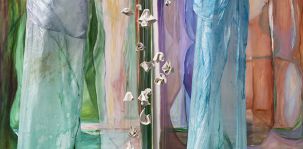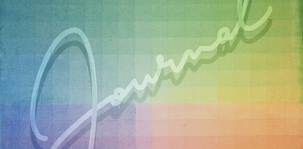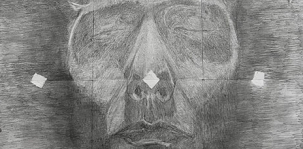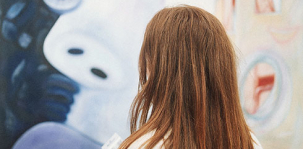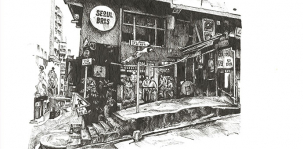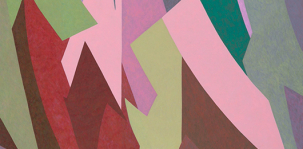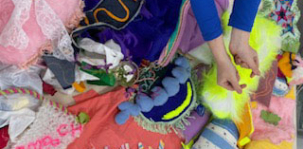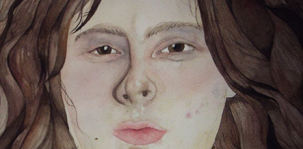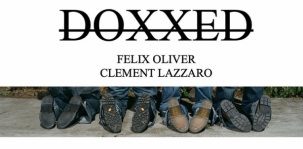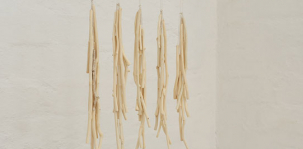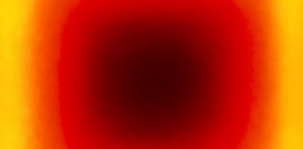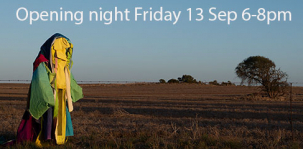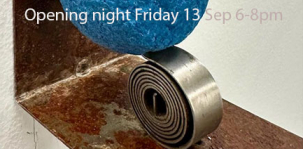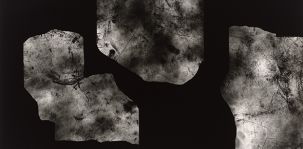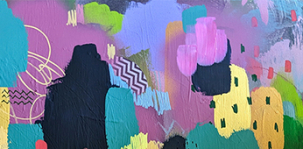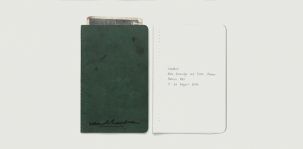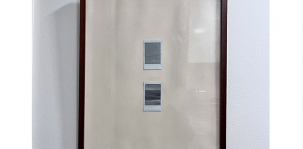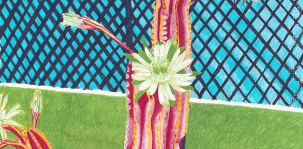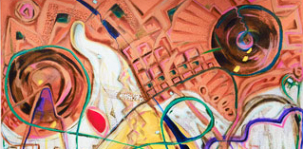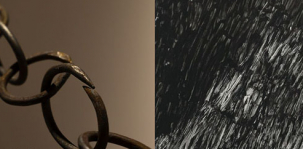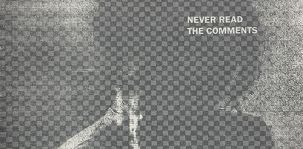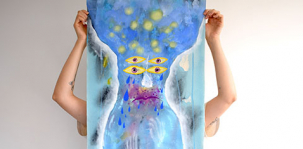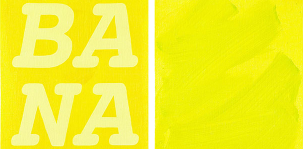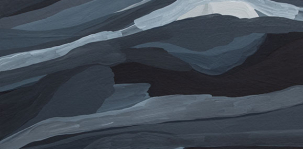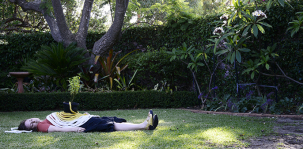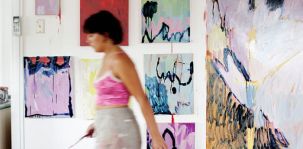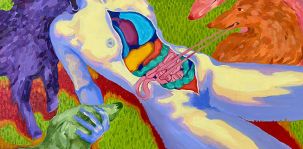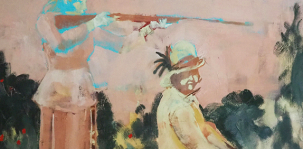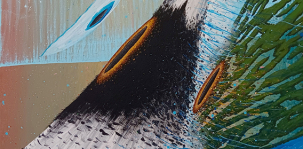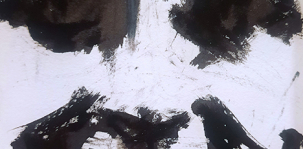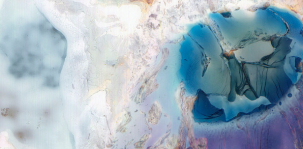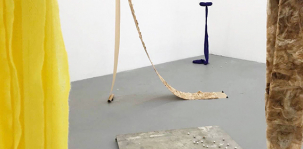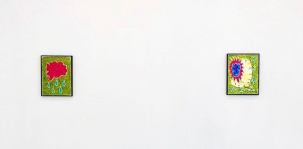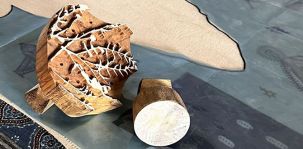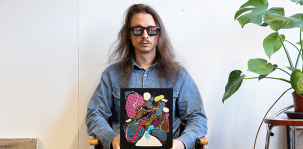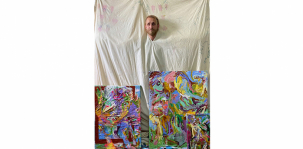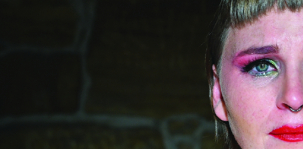Archive : 2024
November 20 - December 7, 2024
Helle Cook
In Light of Everything explores the sensory experience of light, place and belonging in painting and textile installation.
The mobile character of the work illuminates a notion of being carried through time and place, it suspends itself somewhere between Nordic and Australian light and place.
The exhibition follows an ongoing enquiry of taking my practice beyond the studio and into nature. Here, I carefully create ephemeral textile installations before documenting their interaction with the natural elements.
It is an awe-inspiring process which has followed me around the world - it awakens wonder and environmental awareness.
The viewer is invited to touch and immerse into the work – and to venture beyond horizons to a place where light and collective awareness unfolds and embraces - In light of Everything.
Helle Cook is a Danish-Australian artist based in Meanjin/Brisbane. Having lived and worked in and between dual 'homelands' she explores sensory and memory perception in expanded painting.
Holding a Bachelor of Fine Art (Honours) from Queensland College of Art, Helle has had solo and group exhibitions around Australia. She has been artist-in-residence in Australia, Italy and Denmark.
Marcel Feilafe
In 2022 Feillafé exhibited a series of over 50 watercolours in an exhibition titled Journals. These works, through the use of repetition, layering and abstraction explored the capacity for drawing to represent the passing of time. In 2024’s, Journals II, Feillafé launches off from here to further examine how journals and artworks, over time, have the capacity to become vatrines of existence, ones which allow for; observation, investigation, imagination and potentially epiphanies. In these new works the artist will experiment with the potential presented by expanding from the more intimate scale to a much larger and immersive experience.
Patrick Zaia
Fanged, Skinned & Shrieking is concerned with notions of animality and its attendant figurations across history. Comprised of drawings and sculptures, the exhibition draws upon myth, philosophy, art history and online subcultures in order to contemplate the ways in which animality has been used to disrupt and oppose idealised conceptions of modern culture and society. Whether viewed as divine or debased, to become a beast, to will oneself into an animal state, is to voyage into the feral wildernesses beyond the technological polis of enlightened, liberal humanism. In a poetic register, Fanged, Skinned & Shrieking considers how artists and writers of the past have explored the transgressive potential of ‘the human-animal’ so as to recognize its many resonances and manifestations in our present-day culture.
Patrick Zaia is an artist, writer and musician based in Brisbane/ Meanjin, Australia. Ideas around horror, aesthetics, alienation, and the non-human constellate and interconnect throughout his cross-disciplinary practice, forming large-scale installations that are both humorous and unnerving in equal measure. These ideas are further refined and articulated in his writing, which encompasses catalogue essays, articles and reviews. He has exhibited widely throughout Australia and his writing has been published by a number of national and international journals, magazines and galleries.
October 30 - November 16, 2024
Lena Stumpf
‘Cookie Dough’ is a body of work that explores the interconnectedness of personal healing and the well-being of our environment. With a dreamy colour palette reminiscent of sweet treats, the artworks represent a journey of self-discovery towards inner peace.
Blending abstraction and figuration, the paintings are created through intricate layering techniques built on gestural brushwork. Inspired by the boundless movement of nature, biomorphic shapes emerge organically, guided by emotion and memory.
Lena Stumpf is a painter and interdisciplinary artist living in Melbourne on the stolen lands of the Wurundjeri people. Her works are held in private and corporate collections across Europe, the Americas, and Australia. Stumpf is a finalist in this year's National Emerging Art Prize.
Julia Schmitt
I visited Hong Kong in 2018 and completed a series of drawings in 2018-2019. These works depict places that no longer exist. Famously in 2022, the Floating Reastaurant on Aberdeen Harbour burnt down in a fire. The drawings capture the intricate urban environments that blend tradition with modernity. Hong Kong is a place of contrasts and these drawings capture the Taoist temples, wet and dry markets, hipster cafes, antique stores and high-end art galleries and boutiques
Claire Mooney
At almost every conceivable level of our imagining, it is impossible to create a change without a discontinuity, without a moment of not knowing who we are, or what we are going to become. Rupture precedes revolution.
Ruth Allen “Weathering”
Pattern Evolution explores transformation and change through the interplay between pattern and colour, fragmenting and interweaving geometric forms to create evolving configurations.
Using collage as a starting point, I create the conditions for new structures to emerge in the work. Through these processes of cutting, displacing, layering and concealing I can invite the principles of disorder and chance into my systems of creation, responding to interactions between the patterns and chasing the surprising beauty that can arise through the resolution of imperfect alignments.
Claire Mooney is an artist and art teacher who lives and works in Naarm/Melbourne. Her practice explores the metaphorical possibilities of pattern and abstraction through the mediums of painting, drawing and textiles. She completed a Bachelor of Fine Arts at RMIT in 1999, a Master of Visual Art at the Victorian College of the Arts in 2004, and a Postgraduate Diploma in Education at The University of Melbourne in 2010.
October 9 - October 26, 2024
Phoebe Thompson, Lil Longman, Zeth Cameron & Holly Goodridge
Picture yourself rummaging through the sale haberdashery section, or digging through fabric offcuts in your local op shop. Picture your kooky friend's childhood bedroom. Picture the weaving shapes and colours of the queer club bathroom exploding around you.
This group show investigates textiles and soft sculpture as objects evocative of, and imbued with play, sensuality and care. Embedded within these tactile, textural objects and their slow creation, is an innate intimacy and comfort owing to their closeness to the body and their kinship with well-worn childhood stuffed toys or blankets.
Textile arts—historically denigrated as ‘low art’, ‘women’s crafts’, or marginalised as mere labour—have been used in queer artforms to navigate and investigate social boundaries. Here, the uncanny valley of sexual and sensual (and ridiculous, over the top, flamboyant et cetera) queer aesthetics overlaid with youthful nostalgia challenges the hierarchy of the traditionally male, individualistic, ‘professional’ white box gallery. Textile arts come with metaphor innately woven into their fabric as literal connective methods and motions that bind and bring together. Meanwhile the works themselves, created in collaboration and conversation joyfully and foolishly interact, connect, and intermingle, in an ode to strongly interconnected communities.
You are invited into our intimate, sensory space, to touch and feel, play and be. Go on, have a giggle. We dare you! ;)
Tash Jackson
This exhibition evolved and its overall concept changed with each painting I created. I despise the fact that I have to sum the process up within a paragraph. But if I have to…….
Auras is an exploration of the different ideas of femininity created by society. Most of the pieces are homages to stereotypes society inflicts on women. This series of surrealist watercolour portraits present stereotypical concepts of femininity such as, being feminine is having long hair, women should smile more, women should dress ‘femininely’.
The one outlier in the series is Sarah, a moment captured mid conversation that I’m sure many of you will invent your own version of what it implies and what she was thinking at the time. Historically, women in art were rarely presented with anything other than a serene expression on their faces and I see no point in continuing with presenting the same idea of what women feel, think and are.
Tash Jackson is a Melbourne/ Naarm based watercolour artist. Romanticising the world surrounding her is essential to how she experiences and views it. Using predominantly watercolour on paper, Jackson presents her inner romantic views of society, familial relationships and femininity.
The process of breaking down and dissecting an image allows her to take her time immersing herself in the process of creating a symbolic image. Jackson creates intimacy by spending time with her works. Her compulsion to allow the work to develop at its own pace results in the daydreamed perspective that she conjures up in her mind. She uses imagery that is surrealist, symbolic and figurative in nature, bright and unrealistic in colour to present her romanticised perspective.
Jackson is currently exploring different avenues of creating large scale paper works. She does this by using multiple panels in a jigsaw formation that seamlessly fit together. This method is complementary to her process of dissecting an image into elements, which is essential to her development of a piece.
While exploring this avenue of creating large scale works, Jackson was fortunate to be nominated as a finalist for the Biennial Flow Watercolour Artist Prize 2023.
Felix Oliver & Clement Lazzaro
Import cigarettes, counterfeit luxury, dupe core, forgery. A palimpsest of fuckery. A chronically online enclosure brink with radicals. Pressed tin painted gold. Pleather. TikTok physicality. The contemporary as a counter culture to whatever proceeded it. Techno accelerists, incels, neo liberals, neo anarchists and neo neo’s. Then there is Morgan Bistro, his TikTok architectures, his brutalist bakehouse. I bet he has a cavoodle. It’s zoo architecture, captive formalism. He’s a cwassant corbusier.
A hidden language of gestures at play. Signals, side eye, funnelled domination. An elusive space to be surveilled.
I notice these rituals now, my every move as a microcosm. Happenings at the not so sacred.
The counterfeit as a material counter culture. Hulk Hogan opening the proceedings at the RNC by ripping his shirt off and revealing a trump 2024 wife beater.
Centred through loss, memory, and ownership, Felix’s work examines relations between the constructed natures of ideas, symbols and rules. He considers what occurs when shifts are undergone, what is torn away, and what could possibly be filled into these lost spaces.
Through orchestrated photography, Felix’s practice captures conversations of gesture. How do we embrace each other while traversing undercurrents? Navigating; the fluidity of despair, support and release in an attempt to embody the experience and tension of change.
Felix’s practice studies the experience of holding on tightly to another while observing memory shifting, distorting and fleeting.
Clement Lazzaro is an artist living and working in Naarm. He investigates the possibilities of the counterfeit as a counter cultural material.
The theatrics of the dupe and the crude histrionics of the radically online political enclosure. This is conceived through a sculptural practice, with an emphasis on precious metals, fabrics and gem stones.
September 18 - October 5, 2024
Gaia Walicka & Nao Hirata
Empty Chaos explores the metamorphosis and the merging spaces of the in-between, through an expanded and experimental jewellery and object practice. We embrace chaos, abstraction and formlessness in metamorphic zones between bodies, objects and spaces. Through investigating the relationships between you and me, inside and outside, self and world, we speculate on new possibilities and perceptions of self.
Sarah Lockey, Jacqueline Nguyen, Sarah Marie Jones
The role of jewellery, be it decorative or symbolic, is to add beauty and meaning to our daily lives. However not all that is beautiful is merely seen or even touched. Some things are best felt.
‘A Sense of Jewellery’ is an exploration into the audible and sensory experience of jewellery. Moving beyond the physical, this exhibition explores a different understanding of the jewellery object, and how its beauty might be realised via its ‘music’.
Like the sound of tiny chiming bells suspended from your ears or the jingling of metal chains strung around your neck. Like the clacking of your ring as your hand alights the table or the jangling of many bangles as you dance around the room. Small sounds capable of eliciting emotions and even memories, they hold the capacity for a new experience of jewellery.
Leonie Leivenzon & Mira Krulic
This exhibition explores colour through the modern primaries of cyan (C), magenta (M), yellow (Y) and black (K- key). Combining CMYK can produce an almost limitless number of rich hues, tints, tones, and shades. However, getting the desired colour involves a painstaking process of mixing and experimentation, whether to match the colour of an object or to account for the differences between screen and printer. For this exhibition, Leonie and Mira have created new bodies of work using their respective mediums of paint and the camera lens to explore the endless possibilities and outcomes from these four basic elements.
Leonie is a multidisciplinary artist based in Naarm/Melbourne. She uses found objects as a means of exploring the narratives we hold around things, the self and each other. A paint swatch found in a second-hand book sparked an interest in colour mixing, inspiring her to use paint to match the colours of found objects. Through this process Leonie examines how colour impacts our relationship with things and prompts creative expression.
Mira Krulic is a Melbourne-based multidisciplinary artist. Her current practice focuses on photo-media, transcending the boundaries of traditional photography. Through her lens, she transforms found objects with light and colour to evoke ambiguity and mystery. Mira explores the dynamic interplay between visible colour and the invisible object, examining how colour influences mood, emotion, and perception, creating an immersive experience.
August 30 - September 16, 2024
Mairin Briody
Dancing on the foggy coast
an expanded and evolving painting project by Mairin Briody
“To find a new world, maybe you have to have lost one. Maybe you have to be lost. The dance of renewal, the dance that made the world, was always danced here at the edge of things, on the brink, on the foggy coast.”― Ursula K Le Guin, 1981
Dancing on the foggy coast is a process driven and experiential, expanded painting project. Improvising with pre-painted canvas strips, my practice aims to engage narratives of the body to explore themes of uncertainty and the unknown.
Inspired by the writing of German art critic and theorist, Isabelle Graw, my practice is consumed with answering questions of how paintings gain agency. How do paintings develop vitality, how do they expand into a life of their own? For me, the answer is to reduce the space between my body and material, and to engage in a process of improvisation so as not to impose a conscious agenda.
For a while now, I’ve been caught on a new question; what is a painting in a world falling apart? It feels as if everything is in tension and I can’t bear to pull a canvas taught across a stretcher bar.
I want to fold, fall. To gather myself up. Let myself go.
My body, like all bodies, is marinating in the tangle of this uncertain time. We are witnessing the vibrancy and vitality of our world be consumed. Stunned by the consequences of this furious and barbaric civilisation. Wrestling with the weight of it. Praying for renewal. Dancing on the foggy coast.
The works in this exhibition were produced on the unceded lands of the Wadawurrung, Dja Dja Wurrung and Narungga peoples. I also acknowledge the Wurundjeri Woi-wurrung peoples on whose land this exhibition is displayed and I pay my respects to the elders past and present. This always was and always will be Aboriginal land.
My thanks to the Ballarat Arts Foundation for the small equipment grant I received allowing me to purchase a camera used to produce these works.
Jade Cargil, Sophie Malvestuto, Deborah Mchugh
Although different in sculptural conclusions and processes, the three artists engage with materials and concepts with a similar framework of values. By filtering natural phenomena and thoughts through their own experiences and histories, the artists begin experimental anditerative processes, coming to materially rich outcomes. The meeting of the self and material autonomy allows new physical forms to manifest, that merge and hold the trace of the artist's story within the marks made on the objects, while also listening to the material's histories and what they express.
The connection between our hands and our process is wholehearted. Our hands bear the weight of materials, objects and experiences. Through our hands we hold and hew, so that we may form a material into something close to us.
Claire McArdle, Melinda Young, Zoe Brand
Veneer brings together the work of Claire McArdle, Melinda Young and Zoe Brand to explore the concept of surface as a liminal space in the context of jewellery. This place, between the internal and external, is the focus of work which questions the values implied and intended when encountering this threshold. This subject is examined by each artist through the lens of their own practice, applying distinct ideation and materiality.
Claire McArdle is a jewellery and object maker with an interest in tools, performance and the making process. Claire recently completed her PhD at RMIT University and was included in Melbourne Now at the National Gallery of Victoria in 2023. She won the Itami Award at the 2019 ITAMI International Jewellery Exhibition, first prize at both Contemporary Wearables '13 and the National Contemporary Jewellery Award in 2016 and received the Excellence Award at the Victorian Craft Awards 2017. In 2023 her work was collected by the National Gallery of Victoria and in 2018 by the Musée des Arts Décoratifs, Paris.
Born in Brisbane, Australia in 1984, Zoe Brand is an artist, jeweller, and truffle hunter living and working on Yuni country (Majors Creek), NSW. Brand is well known for her text-based wearable signs and conceptual jewellery pieces and uses these to explore the performative nature of jewellery as a device for communication. Brand has showcased extensively across solo exhibitions and group shows worldwide, including Australia, New Zealand, Thailand, Germany, France and the United States. Her works grace significant private collections. Before meeting her partner and becoming mother of two, Brand was the Director of the Personal Space Project, a gallery located in her bedroom.
Melinda Young lives and works on Dharawal Country. Her research-based practice spans jewellery and intimately scaled textiles reflecting experiences of being in and understanding place, underpinned by complexities of place-based making in contemporary Australia. She is interested in materiality - the traces of human and non-human interactions left behind on the body and the land. Exhibiting extensively in Australia and internationally since 1997, her work is held in public collections and included in numerous publications. Melinda is an Associate Lecturer, Faculty of Arts, Design & Architecture UNSW and undertaking a PhD in Human Geography and Creative Arts, University of Wollongong.
August 7 - August 24, 2024
Sarah Ritchie
Adrift in Darkness and Light features a series of hand-printed camera-less photograms, representative of Sarah Ritchie’s ongoing interest in and exploration of the rich, intersecting relationship between darkroom photography and printmaking processes.
Transparent polyester is used as a substrate to create each negative. The polyester is roughened with sandpaper, then smoked in the manner of a hard-ground etching plate with the resulting blackened surface of the soft polyester strategically removed, scratched, and worked with printmaking tools and firm-bristled brushes. These hand-drawn marks create a field of semi-transparent windows through which light can travel in the contact exposure process in the darkroom.
While the aesthetic of the individual photographic prints appears surreal and whimsical, each series is installed in distinct groupings within a grid format to deliberately imply an ordered and controlled view of what could be a topographical map, apertures onto a physical landscape or a chart of an imagined cosmos.
Sarah completed a Bachelor of Fine Arts (First Class Honours) at RMIT University in 2002 with a major in printmaking.
Jason Harris
Become Whatever is a collection of work that explores sense of self and sense of place, and the chal- lenges faced when you’re a product of contrasting cultures, societal ideologies and minority groups. This identity crisis is manifested through personal symbology, colour, and ghostly forms.
JC (he/they) is a multidisciplinary artist and designer based in Melbourne. His work explores the hybridity of his Asian (Filipino) and European (German/Australian) descent and their impact on his experience of identity, sexuality, sense of place and the duality of a perceived otherness.
He completed his BFA at the Victorian College of the Arts (VCA) and his studies in graphic design at RMIT University.
Asha Beveridge & Oscar Palmer
'Landlock' is an exploration of the objects we associate with grieving and the remains of things past. Through our works, we examine our emotional archive, divulging our personal histories, seeking to understand how we process and understand loss and the mourning of a past we may no longer engage with. With each exploration, materialising ideas is an attempt to challenge our emotions, relating to how we perceive our past experiences, guiding us to a place of acceptance and understanding. The works in 'Landlock' play on the solitude of mourning, questioning why we hold on to certain objects and places.
Oscar Palmer is an interdisciplinary artist based in Naarm/Melbourne. Oscar’s work explores what has been lost and the idea of remembering what once was. His work is an attempt to challenge his own emotions, relating to the way he perceives his past experiences, and guide them to a place of acceptance and/or understanding. He plays on grief, materialising it through way of painting and sculpture. Fascinated by neglect and the concept of something ageing or being ‘used’ unto it, Oscar’s subject matter often makes use of found and recycled objects and materials. Finding the beauty in the turned away and concerning himself with why.
Asha Beveridge is an image maker and sculptor based in Naarm/Melbourne. Asha's work draws focus on the complexities of the objects and places we hold dear, seeking to understand our attachment and draw to them. Asha is in their first year of a Bachelor of Fine Arts (Photography) at The Victorian College of Arts. Their most recent show was 'Root Rot' at Oddany Gallery, with their first solo show at 138 Gallery titled 'A Fabricated History'.
July 17 - August 3, 2024
Alannah Borg
Focused on the intricacies of silver fragments, 'Silverfish' delves into the intimate and purposeful details, interconnections, and residual imprints that shape our experience. Through a homogenous collection of sculptural, ceramic, and photographic mediums, this showcase inherents a sense of fluidity that characterises the varying rhythms threading through our lives.
Alannah Borg is a Melbourne based sculptural artist. Her work predominantly focuses on small details with traces of memory and the feminine lens through natural and raw mediums such as wood, silver and paper.
Misako Nakahira
Misako's recent works are primarily stripe-based tapestries. Historically, stripes have been used to draw attention, and she is particularly intrigued by this. Additionally, her previous works are predominantly composed of yellow, a color that not only captures attention but also conveys a sense of happiness. During her stay in Melbourne, Misako actively incorporated the techniques she learned at the Australian Tapestry Workshop, where she was an artist-in-residence, to explore new ways of creating colors for her work. She sought to discover new colors to incorporate into her art, experimenting with patterns inspired by everyday discoveries and exploring the interaction of colors.
The exhibition title, "INTERACTION," signifies not only the overlapping of lines and colors but also the relationships between people and objects. It is fluid and never stops, like a towel swaying in the wind.
Misako Nakahira is a textile artist based in Kyoto, Japan. She holds both a bachelor's and a master's degree from Kyoto University of Art. In 2023, she was selected as an overseas fellow by the Pola Art Foundation, which allowed her to spend a year in Melbourne for textile research and creative production. During the same year, she was also chosen as an artist-in-residence at the Australian Tapestry Workshop, where she continued her work. This exhibition showcases the works she created during her time in Melbourne.
Katie Starkey
‘June 2023 to June 2024’ is a study how plants change with the seasons, and a reflection on the universal theme of impermanence. Each of the 12 coloured pencil drawings in this series is a response to a seasonal change observed in plant life in inner city Naarm / Melbourne over the past year.
This project is the fourth solo show by emerging visual artist Katie Starkey. Katie lives and makes art on Wurundjeri Country. She is currently a studio artist at River Studios, managed by Creative Spaces.
June 26 - July 13, 2024
Anthea Vayonitis
Anthea Vayonitis, an emerging contemporary artist, moves through dance and meditation practices to create gesturally embodied and sensory paintings. 'Connective Chromatic Energies and Sensations’ is an immersive exploration of an intuitive process that seeks spiritual contexts and metaphysical energies found in nature. Meditation, music, dance, and nature cultivate channels and pathways for her spontaneous and intuitive art practice. Abstraction and biomorphic formations assist in developing a visual lexicon. Vayonitis' works are an extension of her embodied energy and physical movements. In working on large scale paintings, her limbs are at full extension which can be traced through the energy in her markings. Spatial depth is explored through colour to create sensation and movement. Rhythm and refraction are expressed through her free-flowing bodily movements, creating a play of synergistic directions of gestural brushstrokes.
Brigid Meredith & Johanna van der Linden
Material Ecologies explores material ecologies, dualities and tensions through expanded painting, sculpture and installation. A joint exhibition between two female identifying artists, Johanna van der Linden and Brigid Meredith, Material Ecologies explores their ongoing interest in the intersections between materiality, feminism and studio practice. Brigid’s encaustic and metal works explore materiality and the expanse of painting practices. Approaching her process in an intuitive manner, the material explorations facilitate a broader inquiry into notions of the post-human feminist sublime. Johanna presents recent works made as part of an ongoing research project into Catholic materiality and feminism. Alongside new etching work, forged steel chains, spikes and hooks further consider the material entanglements of heaviness, force and embodiment. Using materials such as steel, wax, etching and paint,Material Ecologies consider the ways in which materials can implicate the body through texture, colour, scale and relationality.
Jacob Baglin
This group of paintings and drawings seem to be made in the last year (see title of show). Continuing with what looks to be the same subjects and developing or just changing the approach to touch. Portraits and a nude occupy a firmer position here then past exhibitions. In fact these heads dominate the landscapes they could have come out from although there are no figures in the landscapes.
Supports appear worked and reworked, layers upon layers until they are thick enough or the correct weight, or have lost weight in the case of the drawings, to be considered finished. Browns and ochres, reds, yellows, fairly standard pallet for an early 19th century english landscape painter inspired by the Dutch painters. Constable wouldn’t be a fan though, preferring a natural pallet. When gazing into the turgid earths and spots of charcoal one does realise a depth and charm, a presence perhaps, an entering occurs and reading begins to be possible. Surfaces are protruding off the support and are made of colours that are typically unattractive to us, these things are repulsive in there physicality and resistant in design. Thick paint can be a shallow effect, a crutch for some practitioners, but like the accumulated pigment the repulsion is surface level and there is a warmth and knowing.
June 7 - June 22, 2024
Sarsha Demirci, Rubyanna Edwards, Jana Papantoniou, Kat Rae, Drey Willows and Lala Zarei
Inter - print - ations presents a collective showcase of print honours graduates pushing print media beyond its borders. Our work examines the position of printmaking within a contemporary arts context, investigating how traditional art practices can be expanded to realise complex conceptual ideas.
Sarsha Demirci, Rubyanna Edwards, Jana Papantoniou, Kat Rae, Drey Willows and Lala Zarei all emerged from their training in printmaking curious to disrupt and extend their foundational print grounding which was rooted in order and tradition. This unlikely group of printmakers have been influenced not just by traditional printmakers and print technique but by mediums such as painting, photography, ceramics, sculpture, installation and digital technologies.
May 15 - June 1, 2024
Angela Hughes
'Planetary boundaries' are a framework to describe limits to the impact of human activities on the Earth. Beyond these limits, the environment may not be able to self-regulate or repair any longer and will become uninhabitable for humans and most non-human animals. Crossing a planetary boundary comes at great risk of abrupt environmental change. Much like the pivotal shift from the Holocene to the Anthropocene marks the undeniable influence of humanity on Earth’s natural systems, this series serves as a commentary on the evolving relationship between nature and human civilisation. Each project captures a snapshot of this transitional phase, where elements of nature and humanity coexist, often in conflict. There are many actions that can be taken to slow this transition, but most of us are just along for the ride."
Jemima Longworth
Jemima’s work is about regaining control over the perception of the naked body and creating a safe space for people to not only feel comfortable in themselves but to also be celebrated.
Jemima’s work is inspired by women and non-binary folk’s experiences with how they have been treated based on their bodies. Their aim is to spark conversations about body acceptance and unnecessary sexualisation they have experienced. While providing people, but more specifically fat people, a chance to see their bodies represented in a fine art capacity. There is constant discrimination and sexualisation to deal with when you are fat hence Jemima is regaining control over the perception of the naked body.
Lucija Zaja
‘Inner Saboteurs’ is a collection of works that tell a story of artist’s struggle with understanding herself, her own personal as well as collective history, and the world she lives in. She is exploring past, traumatic events and how they transpire through our everyday lives. The questions raised often refer to integration and awareness of trauma, and how these events linger in our lives, even more so if we try to ignore them. These paintings are an invitation to embrace our tragedies and demons, and allow all of our parts to stand together equally in order to understand ourselves better.
Lucija Zaja is a Sydney-based painter. She was born and raised in Croatia, but later she moved to Berlin which had a powerful influence on her. Most of her inspiration Lucija draws from violent history that both places faced, and the fact that even though life continued, these traumas will always be present and define their future. In her work, Lucija is exploring her emotional and mental landscape, her history and upbringing, and constant battle between good and bad in our minds. These polarities transpire through Lucija’s work, forming visual representations of her inner states. So far she has exhibited in Berlin, Sydney, and Melbourne.
April 24 - May 11, 2024
Aaron Perkins
One banana, two bananana, three banananana…
Fruit/berry/herb: an irregular plural holds up the banana as an absurd symbol of nuance through a series of text paintings that articulate an alternative grammatical numbering system for the plural form of banana.
Aaron Perkins is a Naarm-based artist with a conceptual text-based practice that playfully explores the role of language within knowledge formation through strategies of graphic, typographic and orthographic abstraction. He has a keen interest in fiction and holds a Doctorate of Philosophy from the Queensland College of Art for his research into the potential of fiction and autofiction within painting.
Caitlin Rigby
‘Last Winter’ is an exhibition of paintings from seasons past. Night scenes of moonlit oceans, garden blooms, and vistas become a visual ballad of organic symbolism. Rigby's artistic explorations are embedded in intuitive painting techniques. Layered brushstrokes emerge and reveal as well as conceal and obscure. What remains is the evidencing of gesture in dynamic evolution: a composition that can only happen from building upon what was set down before. Harmonious interplay of a skilfully handled palette of blue hues, ‘Last Winter’ invites viewers to delve into the poetic landscape and melancholic beauty of Rigby’s imagination.
Dani Andree
Tethering now critiques a Western mode of relating to plant-life founded on the reductive, calculative predetermination of living beings through their usefulness as resources. With destructive material outcomes, the exploitative practices promoted by such worldviews compromise relations between living beings. Principles of extraction, cultivation, speed, and supersedence exemplified in the industrial production of textiles and clothing provide a context for understanding why and how the forms in Tethering now have been made.
At the centre of Tethering now is an ongoing practice called the nourishment ritual, undertaken since 2021 in the gardens of the artist and a Tagetes lucida plant’s changing residences. Observations and contemplations transmitted within this nourishment ritual are starting points for the mixed-media and time-lapse pieces in the exhibition. Here, the textile form is reclaimed as a palimpsest; tracing, tracking, and shaping the development of the plant-human relationship depicted in the nourishment ritual. These emergent material outcomes foreground the ontological difference embedded in such relations.
The requisition of the artist’s focus and movements necessitated by the nourishment ritual has been central to the cultivation of a disposition where meditative-contemplative thinking and its potentialities can be realised. A kind of vegetal training of human movement and thinking is realised through the repetition, duration, and location set apart from everyday demands placed on the technologically immersed body. The inverted plant-human relations of cultivation implicit in this training imagines a holding of the artist and viewer in place, on call for the Tagetes lucida.
Dani Andrée is an artist and research candidate at RMIT University, Naarm (Melbourne). She has an interest in the way that functional, everyday spaces enter our conscious awareness. Spatiotemporal manipulations, bodily endurance, and breakdowns in function are employed to examine ontological qualities of and relations between matter and bodies in space.
Past projects have included the phenomenal experience of time slippages while walking through city spaces and the domestic as a perpetual point of return. An overarching sensibility throughout her practice is a preoccupation with progression, forward or outward movement.
Her current research posits encounters with plants that consider the tension between their role within artworks as matter and their existence as intelligent, self-determining subjects. Artworks creating the conditions for dialogical relations between plants, the artist and the viewer provide a counterpoint to instrumentalist ways of interacting with plant life.
This exhibition follows Perennial series shown
April 3 - April 20, 2024
Odessa Mahony-de Vries
Spilling Over is loud, colourful, and energetic, putting the handmade front and centre through bold brushstrokes. This exhibition features recent abstract expressionist paintings on canvas and ceramics, pushing the materiality of paint to the forefront using layering, fluidity and sculptural forms. Driven by the physicality of paint and colour, Odessa channels them into an active exploration of process. Working quickly, responding immediately, she navigates the interplay of painterly gestures and dynamic compositions to find resolution. Often, borders are created within the canvas, only to be disregarded and dismantled later by extending the paint and blurring lines.
Tallulah Ainsworth and Sophie Johnson
What do we want? We want to bite and hold and care and hug and love and laugh and bark
Who are we? Just creatures. All just creatures
We want to know what makes us. What lives inside us. What internal mess creates a being?
Pack mentality is an exploration of complex interpersonal relationships through the dichotomy of canines and humans. Sophie Johnson presents an idealized version of human connections, contrasted against the simplicity of animal bonds- depicted by Tallulah Ainsworth. Simultaneously, we confront the dynamics of human interactions, emphasizing the struggle between aspiration and the complexities of daily life. How animals interact and form interpersonal connections is a mirror image of human beings but whittled down to a basic level, uncomplicated. Reflective of everything we want to be and everything we loathe to be. Primal instincts reside within us, awaiting the opportunity to break free from the confines of conscious thought, the dogs are unburdened by this. Their companionship is our catharsis.
Alex Slattery
"Oh, what grievous sin it is!" is an exploration of the subtle, intricate emotions that define our human experience. In this collection of 15 to 20 works, I aim to delve into the juxtaposition of our interconnectedness with the people and world around us with the poignant moments of loneliness that often accompany it. Through my art, I seek to capture the essence of those emotions that are felt but rarely expressed, the moments of quiet contemplation, and the delicate threads that connect us all.
March 13 - March 30, 2024
Dan Withey
"Nature Bridge" by Dan Withey delves into the intricate interactions between humans and intelligent avian species, challenging notions of human supremacy and emphasizing mutual communication across species boundaries. The exhibition serves as a poignant reflection on humanity's disconnect from nature, highlighting our tendency to construct laws and views based solely on human perspectives, often neglecting the profound impact on the world around us. Through introspective exploration, viewers are invited to reconsider their place within the natural world, acknowledging the damaging consequences of our actions on other beings and ecosystems. By abandoning notions of human supremacy, "Nature Bridge" fosters empathy and encourages viewers to become active participants in the interconnected web of relationships that define our existence.
Benjamin Uno
Shingyo sketchbook 2000-2024: studies, bootlegs and remixes towards a complete s11 Heart Sutra
This exhibition is a survey of more than 20 years work on the Heart Sutra series, which was born of my direct experiences with police and state power at the s11 Protests at Crown Casino, Melbourne in September 2000.
From crowd photographs taken across the three days of protest, individual faces of people directly or indirectly involved were chosen at random to represent each of the characters (ideograms) of the Buddhist text known as Hannya Shingyo, the ‘Heart Sutra’.
In other words, instead of 274 characters, my version of the Heart Sutra has 274 faces.
Although I have previously created both photographic and calligraphic versions of the sutra, last year was the first time I had completed a hand-drawn/painted/written suite of all 274 portraits. The work, entitled 守り Protection, will be exhibited later this year. A commemorative book is also being published and will be available at that time.
This exhibition at Rubicon ARI is my third working with this ‘trans-substantiated’ text. It includes studies for 守り Protection, related works not included in previous shows, and earlier works from my archive showing the origins of my approach to image construction and meaning.
Kat Vonic
Otherworld is a series of abstract images with organic details that mimic the natural world. The gallery acts as a liminal space offering glimpses into otherworldly landscapes, inviting viewers to consider themes of fantasy and unreality as a way of interacting and coping with the real.
The work is influenced by cosmic, ‘New Weird’ fiction and its capacity to explore our connection to the natural world and anxieties around massive events such as climate change and species extinction, with narratives often rejecting a nature-human divide and moving toward a less human-centric worldview.
Kat is an emerging artist based in Naarm/Melbourne, working with alternative photographic processes to reimagine the landscape. They completed their Bachelor of Creative Arts (Photography) in 2023.
February 21 - March 9, 2024
Kate Stewart
An immersive installation.
The poetic materialisation
of
instability,
precarity,
transience and dissonance.
Disparate materials
transformed
into an evolving language
of
eccentric
and misbehaving forms.
Renegotiating,
the way we see.
An interplay
between
20th century Minimalism,
quotidian life
and contemporary
embodied practice.
Kate Stewart (b.1968) is an artist based in Melbourne/Naarm. Her multi-disciplinary practice follows a poetic methodology informed by 20th century modernism, phenomenology, and the vitality that can be generated from material play. She has a Bachelor of Fine Arts (Painting) from VCA and is currently enrolled in the MFA program at RMIT. Her work has featured in multiple group shows and is in private collections around Australia.
Piper Tierney
“Sad sad tears of a STAR”, which represents safe and inner healing to Piper’s childhood. The eclectic compositions that hold a child-like sensibility, are reminiscent of day dreams. Confusion, chaos and uncertainty masked with playful energy. The playful experimentation of naive style painting and drawing invites the audience to visit their inner child.
Piper is a Boorloo based mixed-medium installation artist who shares a great appreciation of wood work, sculpture, drawing and finger painting. Piper holds a Bachelor of Fine Art at the University of Western Australia (2019), and a Masters in Art teaching (2023). Most of Piper’s work is heavily inspired by the absurdities of mundanity through painting. Her eclectic compositions have a child-like sensibility, reminiscent of a day dream. Her practise doesn't meander anywhere for too long, this evolutive quality demonstrates her commitment to challenging herself and the constraints of the mediums she works with. Piper’s work is underscored by phreneticenergy, Imbued with a nascent sense of humour, Piper's work doesn't take itself seriously. Perhaps that's the point.
Manasee Jog
The Kothalo project is a translocated, hybrid collaboration collective that ran from 2020-2023 with Sajnuben, Monghiben and Manasee collaborating to create a series of artifacts. This project is part of of Manasee Jog’s PhD, “Crafting the wandering self: Narratives of identity, agency, materiality”
In both collaborations, the forms of Rabari cultural and traditional artifacts are subverted to express more individual concepts. Monghi ben and Manasee created works that speak of identity, and visualising the process that they followed in this project. While with Sajnuben, works were created around creative process, travel + being a rural/urban nomad and what female energies represent.
Both the Rabari craft-artists are termed as collaborators, because they continue to be maker-partners in the true sense and are an integral part of the collaboration - creatively and conceptually. Through this instinctive and playful process, the three formed a collective, where every part of this project was a joint decision, from brainstorming, dialogue to cooperation. This included important creative decisions of form, function, colour, motif.
The three hope this project will advantage individual practices, culture and energies and push all three into a new direction of thought; reinforcing playful, embodied process and symbology into each of their ways of working.
Kothalo is also a callout and hopefully an inspiration to every Rabari artist to believe that her work is as mainstream as any other contemporary artist, has individual agency, and has potential to be exhibited as high art in galleries, world over.
This is a traveling exhibit that has completed its India edit before coming to Melbourne. The Melbourne exhibit celebrates the culmination of the project, which includes six pieces of collaborative artifacts that have traveled cities and countries, prior to completion. Enjoy this visual feast!
આર્ટિસ્ટ્સ: સજનુબેન રબારી, મોંઘીબેન રાબરી એન્ડ માનસિ જોગ
કોથાલો પ્રોજેક્ટ એક ટ્રાન્સલોકેટેડ, હાઇબ્રિડ સહયોગ સામૂહિક છે જે ૨૦૨૦-૨૦૨૩ દરમિયાન સજનુબેન, મોંઘીબેન અને માનસી સાથે કલાકૃતિઓની શ્રેણી બનાવવા માટે સહયોગથી ચાલ્યો હતો. આ પ્રોજેક્ટ માનસી જોગની પીએચડીનો એક ભાગ છે, "ક્રાફ્ટિંગ ધ વન્ડરિંગ સેલ્ફ: નેરેટિવ્સ ઑફ આઇડેન્ટિટી, એજન્સી, મટિરિયલ"
બંને સહયોગમાં, રબારી સાંસ્કૃતિક અને પરંપરાગત કલાકૃતિઓના સ્વરૂપોને વધુ વ્યક્તિગત ખ્યાલો વ્યક્ત કરવા માટે વિકૃત કરવામાં આવે છે. મોંઘી બેન અને માનસીએ એવી કૃતિઓ બનાવી છે જે ઓળખની વાત કરે છે અને આ પ્રોજેક્ટમાં તેઓએ અનુસરેલી પ્રક્રિયાને વિઝ્યુઅલાઈઝ કરે છે. સજનુબેન સાથે રહીને, સર્જનાત્મક પ્રક્રિયા, પ્રવાસ + ગ્રામીણ/શહેરી વિચરતી બનવું અને સ્ત્રી શક્તિઓ શું રજૂ કરે છે તેની આસપાસ કૃતિઓ બનાવવામાં આવી હતી.
બંને રબારી હસ્તકલા-કલાકારોને સહયોગી તરીકે ઓળખવામાં આવે છે, કારણ કે તેઓ સાચા અર્થમાં નિર્માતા-ભાગીદાર તરીકે ચાલુ રહે છે અને સહયોગનો અભિન્ન ભાગ છે - સર્જનાત્મક અને વૈચારિક રીતે. આ સહજ અને રમતિયાળ પ્રક્રિયા દ્વારા, ત્રણેએ એક સામૂહિક રચના કરી, જ્યાં આ પ્રોજેક્ટનો દરેક ભાગ વિચાર-મંથન, સંવાદથી લઈને સહકાર સુધીનો સંયુક્ત નિર્ણય હતો. આમાં ફોર્મ, ફંક્શન, કલર, મોટિફના મહત્વના સર્જનાત્મક નિર્ણયોનો સમાવેશ થતો હતો.
ત્રણેયને આશા છે કે આ પ્રોજેક્ટ વ્યક્તિગત વ્યવહાર, સંસ્કૃતિ અને શક્તિઓને લાભ આપશે અને ત્રણેયને વિચારની નવી દિશામાં ધકેલશે; રમતિયાળ, મૂર્ત પ્રક્રિયા અને પ્રતીકશાસ્ત્રને તેમની દરેક કાર્ય કરવાની રીતોમાં મજબૂત બનાવવું.
કોથલો એ એક કૉલઆઉટ પણ છે અને આશા છે કે દરેક રબારી કલાકારને એવું માનવા માટે પ્રેરણા મળે છે કે તેમનું કાર્ય અન્ય સમકાલીન કલાકાર જેટલું જ મુખ્ય પ્રવાહનું છે, વ્યક્તિગત એજન્સી ધરાવે છે અને વિશ્વભરની ગેલેરીઓમાં ઉચ્ચ કલા તરીકે પ્રદર્શિત થવાની સંભાવના ધરાવે છે.
આ એક પ્રવાસ પ્રદર્શન છે જેણે મેલબોર્ન આવતા પહેલા તેનું ભારત સંપાદન પૂર્ણ કર્યું છે. મેલબોર્ન એક્ઝિબિટ પ્રોજેક્ટની પરાકાષ્ઠાની ઉજવણી કરે છે, જેમાં પૂર્ણ થયા પહેલા શહેરો અને દેશોની મુસાફરી કરનારા સહયોગી કલાકૃતિઓના છ ટુકડાઓનો સમાવેશ થાય છે. આ દ્રશ્ય તહેવારનો આનંદ માણો!
January 31 - February 17, 2024
Jesse Avdeikov
The Leftovers is Avdeikov’s first project focused on abstraction, color and textures. The exhibition consists of a series of textile paintings made with hand embroidery and appliqué. The works are made out of recycled and leftover materials from his other projects. Jesse uses old clothes, textiles and sometimes other found objects such as pieces of old broken radio.
In his recent works he has been closely studying the relation of textile art and painting. Applying his knowledge and abilities as a painter to do embroidery and appliqué. That is why he refers to his textile works as “thread paintings”.
Jesse Avdeikov (b. 1986) earned his Master of Fine Arts degree from the Academy of Fine Arts of the University of the Arts Helsinki in June 2020. The exhibition is supported by Arts Promotion Centre Finland (Taike).
Harry Bayston
partytrap
heads high
bottoms up
down the hatches and in we go
OUT
flocks you sort of, not really, ish know
oh
we spent longer getting ready
and tomorrow’s even longer
today
partytrap
Harry Bayston (b.1994, UK) is a Naarm based artist who holds a Master of Fine Art with Distinction from RMIT (2022) and a Bachelor of Fine Art with Honours from UNSW AD (2017).
He has exhibited consistently since 2017 in Victoria and New South Wales with multiple solo and group exhibitions at both commercial and artist run galleries. His work is held in private and corporate collections across Australia and Europe, and has been commissioned for several murals, installations and publications.
Gala Jane
Gala Jane is a mixed-media artist exploring mental health through the use of text, found objects, textiles. Fine, thanks explores Gala’s personal journey in the days, weeks and years after the Lismore floods of 2022 hit, destroying her studio and devastating a community.
The exhibition delves into the aftermath of this natural disaster and shedding light on the challenges faced once the media and government pack up, leaving a town and individuals to figure it out.
Using voice recordings from this time with vibrant colours, found objects and tufted rugs she begins to break down her resilient facade. After nearly two years in the making these works have become part of Gala’s healing journey, culminating in a poignant and raw portrayal of her experience.
